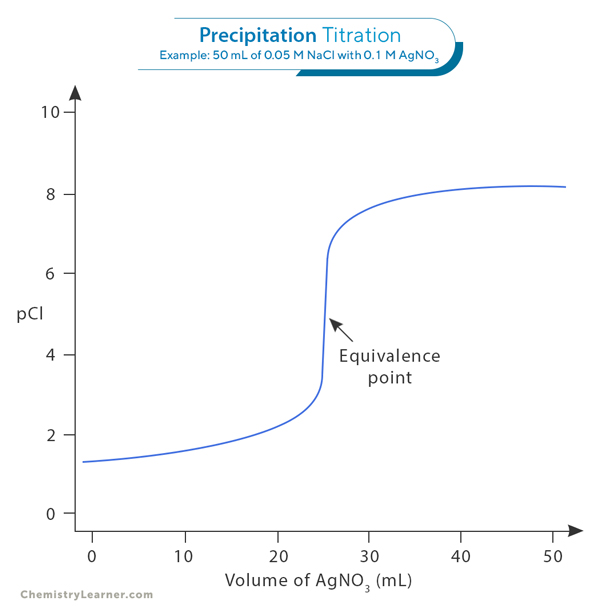Precipitation Titration
Precipitation titration is an analytical chemistry technique that depends on the formation of a precipitate to determine the concentration of an analyte in a solution. This method relies on the reaction between a solution and a reagent, where adding the reagent causes the formation of an insoluble compound or precipitate. The point at which the precipitate formation reaches its equivalence with the analyte concentration marks the endpoint of the titration. [1-4]
Principle
The core principle of precipitation titration is forming a solid, insoluble compound resulting from the reaction between the analyte and the titrant. This reaction occurs under specific conditions, often characterized by controlled pH levels and optimized concentrations of reactants. [4]
Fundamentally, precipitation titration relies on stoichiometry, ensuring that the added titrant reacts entirely and exclusively with the analyte in a precise and predictable ratio. This reaction forms a distinct endpoint where the analyte’s concentration corresponds precisely to the amount of titrant required for complete precipitation. The selection of appropriate reagents ensures the formation of a distinctive and easily recognizable precipitate.
Types
There are three prominent techniques in precipitation titration, each offering distinct approaches and applications in quantifying specific ions or compounds. They are: [3]
1. Volhard’s Method
Volhard’s method operates on titrating the excess titrant after the analyte’s reaction. It involves the addition of a known excess of a silver nitrate solution to precipitate chloride ions, while a potassium chromate indicator helps detect the endpoint. The excess silver ions that did not react with chloride ions will combine with the chromate ions, forming a red-brown silver chromate complex. This method allows the determination of halides, such as chloride, bromide, and iodide, in various solutions.
2. Fajan’s Method
Fajan’s method relies on adsorption indicators to determine the endpoint. The technique is beneficial when forming a visible precipitate is not feasible. It involves the addition of a precipitating agent, where the indicator selectively adsorbs onto the precipitate surface, leading to a marked change in its properties. This change is then used to detect the endpoint of the titration.
3. Mohr’s Method
Mohr’s method uses a silver nitrate solution and a chromate indicator to determine chloride ions. The advantage of Mohr’s method lies in its simplicity and applicability for determining chloride ions in a wide range of solutions. However, its limitation lies in the fact that it is not suitable for determining low concentrations of chloride ions due to the difficulty in detecting the endpoint precisely.
Example
Consider a practical example of precipitation titration involving the determination of chloride ions in a solution using the Mohr method. In this scenario, a silver nitrate solution is the titrant, a sodium chloride solution is the analyte, and a potassium chromate indicator is added to detect the endpoint. The chloride ions in the solution react with the silver ions from the titrant, forming a white precipitate of silver chloride. As the titrant is slowly added to the analyte solution, the initially yellowish solution turns reddish-brown due to the formation of silver chromate. This color change indicates the endpoint, as all chloride ions have reacted to form the silver chloride precipitate. By measuring the volume of the titrant used up to the endpoint, one can calculate the concentration of chloride ions in the original solution. [2]
The titration curve for 50 mL of 0.05 M NaCl with 0.10 M AgNO3 is shown in the image below.
Applications
Precipitation titration finds extensive applications across industries and research domains, playing a pivotal role in pharmaceutical and environmental analyses. In industries, this technique proves invaluable in quality control processes, facilitating the accurate determination of various ions and compounds critical in manufacturing and production. Pharmaceutical analysis relies on precipitation titration to ascertain the purity of drugs, ensuring precise concentrations of active ingredients. Moreover, this method is employed in environmental research to monitor pollutants, quantify elements in soil or water samples, and assess environmental health. [2]
